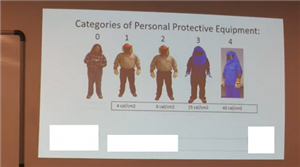This image is from some training in the US, so do the cal/cm2 figures translate to use in the UK, and how do we calculate/determine the Arc Flash level?
Thanks
F

mapj1:
Tis complex. Very complex.
But there are very simple ways to put an upper limit on how bad it could get when it is all stacked against you..
First you can metricate calories to joules with a factor of 4.2 joules per calorie to get a rating for the overalls in real units, as opposed to Diet numbers.
AFAIK the PPE to EU (and UK) standards is all rated in cal/sq cm so you won't be helping yourself doing that … stick to the diet ?
In the UK, our working practices and Forms of switchgear assemblies usually sort this kind of thing out, at least for LV AC. Notable exceptions include types of work done by DNO/meter operator.
DC batteries are another matter. If working with strings of batteries, I'd recommend a risk assessment similar to the process included in the IET Code of Practice for Electrical Energy Storage Systems, 2nd Ed (this is based on the approach in the Australia/New Zealand standard AS/NZS 5139). Hopefully, manufacturers of commercially-available packs have already done this risk assessment for you, and have some recommended practices and instructions, along with the anticipated energy levels for PPE etc.
mapj1:
Tis complex. Very complex.
But there are very simple ways to put an upper limit on how bad it could get when it is all stacked against you..
First you can metricate calories to joules with a factor of 4.2 joules per calorie to get a rating for the overalls in real units, as opposed to Diet numbers.
AFAIK the PPE to EU (and UK) standards is all rated in cal/sq cm so you won't be helping yourself doing that … stick to the diet ?
In the UK, our working practices and Forms of switchgear assemblies usually sort this kind of thing out, at least for LV AC. Notable exceptions include types of work done by DNO/meter operator.
DC batteries are another matter. If working with strings of batteries, I'd recommend a risk assessment similar to the process included in the IET Code of Practice for Electrical Energy Storage Systems, 2nd Ed (this is based on the approach in the Australia/New Zealand standard AS/NZS 5139). Hopefully, manufacturers of commercially-available packs have already done this risk assessment for you, and have some recommended practices and instructions, along with the anticipated energy levels for PPE etc.
We're about to take you to the IET registration website. Don't worry though, you'll be sent straight back to the community after completing the registration.
Continue to the IET registration site